One of the highlights of my Gen Con 50 trip was getting to play a game of Frostgrave with its creator, Joe McCullough. Joe was at Gen Con to promote his new spin-off game, Frostgrave: Ghost Archipelago, and was giving short demos of Archipelago to visitors to the booth. I’ve been very excited about GA, and this was my first look at the new rulebook coming out in October. If the booth hadn’t been so crazy, I might have tried to sit down and read the entire thing through right then and there. Fortunately, I didn’t do that AND waiting on the table when I arrived home was an advanced copy of the rulebook! (Thank you, Christian!)
I didn’t waste any time in opening that package and diving into the book, and below I’m going to share with you what I’ve discovered about the new set of rules. I’m going to do a side-by-side comparison (of sorts) between the original Frostgrave and Ghost Archipelago, pointing out similarities and differences. When the comparisons are done, I also want to share with you the battle report from my game with Joe and two friends, (honorary geek dad) Brian Stillman and fellow GeekDad writer John Booth. I’ve asked both of them about their thoughts on Frostgrave given they were new to the game and will provide their feedback as well. 
Note: The comparisons below assume some knowledge of Frostgrave. If you’ve never played Frostgrave, some of the terminology or rules discussed might not make sense. This comparison is intended for Frostgrave players wanting to know more about the new Ghost Archipelago and how it stacks up against Frostgrave.
Rulebook Design and Layout
Both rulebooks are hardbound and printed in full color. Artwork in both books is by Dmitry Burmak. Frostgrave is 136 pages versus 144 for Ghost Archipelago. Full color photos of painted miniatures are included in both books, with the miniatures being from kits sold by North Star Military Games. New and unique miniatures have been created especially for Archipelago and include the various roles (Heritor, Warden, crewmen, and creatures).
Content is provided in an almost identical order. For Frostgrave, chapters titles are (1) Wizards and Warbands, (2) Playing the Game, (3) The Campaign, (4) Spells, (5) Scenarios, and (6) Bestiary, followed by spell card sheets and The Wizard Sheet (both wizard, apprentice, and warband tracking). For Ghost Archipelago, chapters titles are (2) Heritors, Wardens, and Crewmen, (3) Playing the Game, (4) Playing the Game, (5) Heritor Abilities, (6) Warden Spells, (7) Scenarios, and (8) Bestiary followed by Crew Sheet tracking (Heritor, Warden, crewmen, and ship).
One thing I believe really needs to be stressed about the artwork is the diversity of characters. The 5e Player’s Handbook released by Wizards of the Coast was given a lot of attention for the diversity of races and genders in the artwork. Burmak has created some incredible art for the Ghost Archipelago book… beautiful stuff… with a mix of cultures and races that readers will recognize and hopefully appreciate.

Warband/Crewmen Members
Both games rely on a mix of miniatures (typically 10 per player), d20 dice, and terrain to scatter around the gaming table. Rules allow for 1v1 and 2v2. Both games support a gaming area of 2’x2′, 3’x3′, and 4’x4′. Archipelago does suggest that four-player games start on the corners, rather than along the longer edges of the map.
For Frostgrave, the basic warband consists of 10 members and members of the warband are purchased using 500 gold coins. All players start with a wizard (free). An Apprentice costs 200gc, but is not required (although heavily encouraged). The apprentice has stats that follow the Wizard but are slightly lower. The Wizard and Apprentice both use identical spells. A wizard belongs to one of ten different schools of magic and spell selections will depend on the selected school. The remaining warband is purchased and consists of 15 different classes such as Thug, Thief, Knight, Barbarian, Archer, and more.
For Ghost Archipelago, the basic warband also consists of 10 members that must be purchased using 250 gold coins. Unlike the Apprentice, the Warden is not optional. The Warden’s stats are not dependent on the Heritor (unlike the Apprentice). The remaining eight positions in the warband can be gathered from a mix of Standard Crewman (weapon and shield) and 11 14 Specialist roles such as Crossbowman, Pearl Diver, Scout, Herbalist, and more. The Heritor has a maximum of four Specialists in the warband. Some Specialists have unique abilities in the game, but come at a higher cost.
There are six weapon options for warband members in Frostgrave; Archipelago increases that to seven options plus three armor options (shield, light armour, heavy armour).
Each warband member has a stat line. Stats are identical for both rulebooks and include Move (M), Fight (F), Shoot (S), Armour (A), Will (W), and Health (H). Split Stats are also supported in both books, allowing for spells and other items to have in-game modifiers to Stat values.
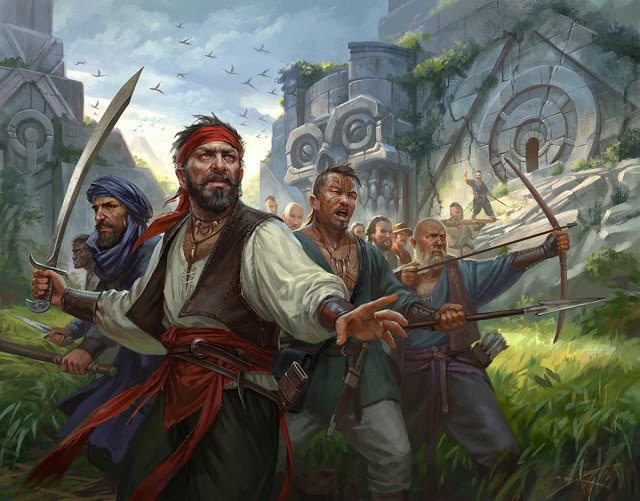
Wizards pick spells, but Heritors select five Heritor Abilities from a list of 30. The rules allow players to pick the five abilities OR agree to use a random to select the powers. Wizards must roll Activation values to successfully cast a spell, where Heritors must roll a Utilization Number. Both games can apply modifiers to these rolls to affect outcomes. The Wizard can take damage if a casting is unsuccessful. Heritors, on the other hand, will take a point of damage every time they use their abilities (successfully or not) PLUS damage if they fail the Utilization roll. This is called Blood Burn and is tracked with a d6.
Wizards can only cast a single spell on their turn. Heritors can use their Ability at ANY TIME in the game when a figure is activated (including an opponent’s figures), if the ability states it can be used in such a manner. The Utilization Roll value increases in difficulty each time a Heritor attempts to use an ability during a single turn. For example, A second use of an ability is at +3 while a Sixth is at +15. The Blood Burn die is also used to track this value.
Wizards and Apprentices belong to one of ten different schools of magic, but Wardens must choose from five branches—Beast, Earth, Storm, Warden, Vine, and Wave. The branch selection will affect spell choices, and Wardens have a maximum of four spells to use (three from the Warden’s branch, one from another branch). The spell of a different branch adds a +4 modifier to the Casting value. Over time, Wardens can learn additional spells and improve the Casting roll values.
Note: Expansions to Frostgrave include additional new roles and creatures. This comparison is only for the core rulebooks for Frostgrave and Ghost Archipelago.
Game Turns
Basic game play starts with setting up the table. Frostgrave takes place in the frost covered and crumbling city of Felstad. Ghost Archipelago takes place on a series of magical islands that appear every few centuries and then disappear. Both games rely heavily on scatter terrain to create tight and narrow areas to fight and to block line-of-sight and help create ambushes and hide surprises (in the Campaigns).
Game play is broken up into Turns. Each Turn consists of moving one or more type of miniatures and/or performing a tasks such as shooting or casting a spell or picking up an object (to name just a few). For both books, players roll a d20 to determine Initiative for that turn. When a turn ends, players reroll the d20 again to determine order of play for the next turn.
Each turn is divided up into Activation phases. For Frostgrave, Wizards go first, followed by Apprentices, and then Warband members and then Creatures. For GA, Heritors go first, then Wardens, and then Crewmen followed by Creatures. Both games allow for Group Activation—basically, any figures within 3″ of either the Wizard/Heritor or Apprentice/Warden may move at the same time as the leader. The Move action must be taken first by all figures before other actions can be taken. (There are exceptions such as the Crossbowman having to reload.) All miniatures take two actions on their turn, one of which must be a Move action.
Rules exist in both books for Falling, Jumping, and moving off the game area. Movement for most figures is a max 6″ per turn with 3″ (or half speed) when carrying and item or for a second Move action.
Combat
Combat rules are mostly identical between rulebooks. Hand-to-Hand combat is done with both players rolling a d20 and adding the Fight modifier. The highest roll wins AND the value of the winning roll is compared to the loser’s Armour. Any amount of the winning roll that exceeds the loser’s Armour value is applied as damage. The winner can also choose to shove the loser back 1″ to separate the figures from the auto-combat that occurs when two minis are side-by-side (1″ apart). Shooting rules are identical, including modifiers for terrain and size of targets.
Archipelago adds Swimming rules. Water in GA is either shallow or deep. Shallow water is treated as rough ground. Minis moving through deep water must make a swimming roll that is modified by their armour type or whether they are carrying treasure.
Multiple combat (1v2, or 2v2) is handled identically with both rulebooks with modifiers applied for neighboring allies or surrounded enemies.
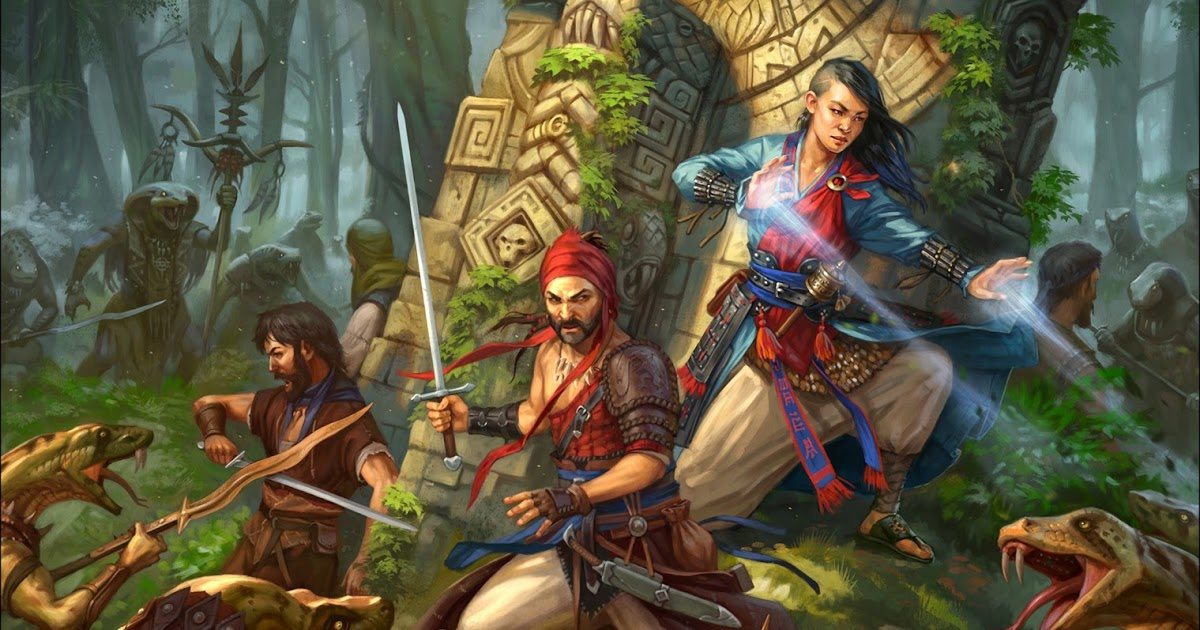
For both rulebooks, empowering spells is allowed on a 1-to-1 basis. Lose one Health, add one to the Activation/Casting roll. Resisting spells is also allowed with both rulebooks when the spell allows for it.
Critical Hit rolls are optional for both rulebooks, and modifiers exist in both books for shooting through cover or friendlies/enemies. There is still a 50/50 chance to hit a friendly when firing into combat.
GA also includes rules for small boats and combat taking place in or around these objects. Depending on the terrain selected for a game, there could be large or small bodies of water, so rules are provided for moving boats and fighting and boarding.
End Game
Both rulebooks state the game will end when all treasure tokens are removed from the table or if one player has the only surviving miniature. Some campaign scenarios in both books have optional victory conditions.
For campaigns, both Frostgrave and Ghost Archipelago provide the same rule for determining whether warband/crewmen are killed outright or injured or other. Wizards/Heritors and Apprentice/Warden also have an identical table for Survival condition that includes Dead, Permanent Injury, Badly Wounded, Close Call, and Full Recovery. The nine Permanent Injuries are identical for both books.
For XP, both books offer tables although the values are different for different types of successes. Heritor AND Warden have different tables to roll one; Frostgrave has only a single table for the Wizard.
Wizards and Heritors gain levels at a rate of 100 XP points per level. Wizards have three options—improve a stat, improve a known spell, or learn a new spell. Heritors can improve a stat, decrease an ability Utilization value, or learn a new Heritor Ability. Apprentices casting stats are linked to the Wizard; the Warden, however, can improve a stat, improve a known spell, and learn a new spell.
Treasure tables are provided to determine what type(s) of treasure is recovered. For Frostgrave, options include gold coins, potions, scrolls, magic weapons/armour, magic items, and grimoires (contain a new spell). GA treasure options include gold coins, herbs/potions, weapons, armour, magic items, and Map Stones. FG offers up a table of 10 potion options and GA offers up 20 herb and potion options. Weapon/Armour AND Magic Item tables in both book offer up 20 options each.
Grimoires are only found in FG and Map Stones are only found in GA. Map Stones provide a bonus +20 XP. There are 10 different types of Map Stones—finding all ten will trigger a complete end game and the winning player will have “found” the fabled Crystal Pool that is hunted by Heritors.
Rules for spending gold coins are provided for both rulesets and include “buying” a new Heritor or Warden as well as warband/crewmen members. With FG, an apprentice can be promoted to Wizard level, but with GA a new Heritor or Warden must be recruited. Rules for determining starting stats is provided for both books. Buying items is supported in both books (although some items are not available for purchase and can only be found).
Frostgrave players in a campaign can establish a Base. Each Base has a type (8 different types) and then 10 upgrades can be purchased for the Base that provide stat modifiers and other special abilities. A Heritor has a Ship, and a table 10 upgrades for purchase is provided. Only one of each upgrade is allowed for the ship.
Wizard vs. Heritor – Spells and Abilities
For Wizards, there are ten schools of magic. Each school offers up eight unique spells. Apprentices have the same spells as the Wizard but cast them at a slightly higher Activation value.
For Heritors, there are 30 unique Heritor Abilities. Wardens have 30 different spells available—six spells per five branches.
Scenarios
Frostgrave provides 10 scenarios. They can be played sequentially or the Random Scenario Table can be used. Ghost Archipelago offers up eight scenarios plus the Random Scenario Table.
Bestiary
Frostgrave provides a Random Encounter Table with three levels of encounter based on number and difficulty of creature(s). Five categories divide 25 creatures that include Undead, Animals, Constructs, Demons, and Miscellaneous Creatures. 10 scenarios.
Ghost Archipelago also provides a Random Encounter Table with three levels of encounter based on number and difficulty of creature(s). Five categories divide 25 creatures that include Animals, Saurians (lizard creatures), Sentient Races, Undead, Aquatics, and Demons.
Summary
Both books offer a standalone game with plenty of replay value and twists and turns for those who engage in an ongoing campaign. The similarities between the two books ensure that Frostgrave players can quickly and easily get to the table and have a great Archipelago game without having to learn new combat mechanics. It’s the differences, however, that will ensure that players don’t feel like they’re just playing Frostgrave in an island setting. The Heritor abilities, rules for boat combat, new spells for Wardens (and their various branches), the new beasties, and the addition of new specialist roles offer up the right amount of new content and surprises for experienced Frostgrave players.
An expansion for Frostgrave offered up the role of the Captain, a warband member who could level up and had special feats the character brought to combat. The immediate inclusion in Archipelago of the Warden as a role that can level up and has its own spells and abilities is a welcome addition to the core book. The new creatures are especially interesting, with a wide mix of island-centric beasts and savages that will certainly bring danger and smiles to the players’ games.
Players should look forward to some crossover games… Frostgrave vs. Archipelago adventurers. The rules do seem compatible at first read, and I couldn’t find any particular Heritor abilities or Warden spells that felt like they’d break the game and make it unfair to core Frostgrave warband members. Time will tell, but I believe crossover games are inevitable and tactics will be discovered to patch up any imbalance issues.
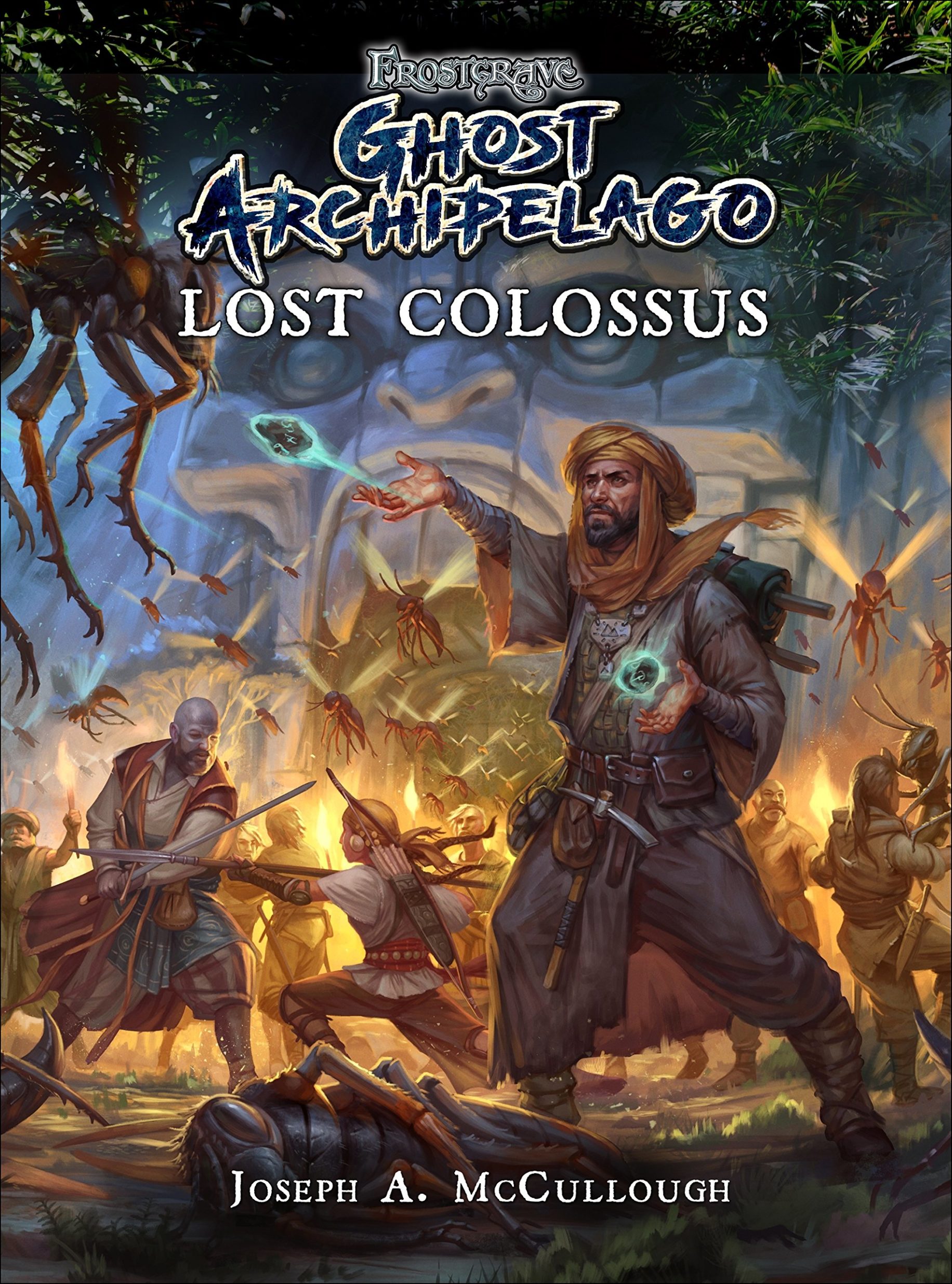

All in all, Ghost Archipelago is an incredible set of rules that takes the strongest parts of Frostgrave (combat, campaign tables, leveling/XP, and great story/locale) and tosses in the right amount of new content and rules to shake things up and give experienced players plenty of surprises.
Frostgrave: Ghost Archipelago releases on October 24, 2017. The tentative date for the first expansion book, Lost Colossus, is scheduled to release on March 20, 2018. Fans of the game will also want to grab the Accessory Pack that includes Ability cards, Spell cards, and the Burn Die (used to track the Heritor’s use of special abilities).
Below you will find some feedback from Geekdad contributor John Booth, and Friend-of-Geekdad Brian Stillman, regarding their first game of Frostgrave played at Gen Con 50 with the game’s creator, Joe McCullough.
John Booth:
I came to this as someone who’d never tried tabletop wargaming due to the time and financial commitments of building armies, buying or crafting landscapes, and painting miniatures. But I do like a good skirmish game that can be pulled together and played in a relatively short time, so I was excited by GeekDad James’ invitation to give Frostgrave a try.
As a complete rookie, I appreciated the low price point for entry: The core rulebook was easily found for less than $20 (official cover price is $24.95, still a bargain for the book’s content and quality), and the only other thing I needed to play was a handful of non-specific miniatures, which were easy enough to gather from my D&D stash. And while James’ incredibly cool, detailed environment made for a great setup during our game, I like knowing that if I wanted to, I could introduce this game to friends with nothing more than an on-the-fly cityscape using whatever’s at hand, and even substitute things like RPG character tokens or 2-D standee figures for the miniatures.
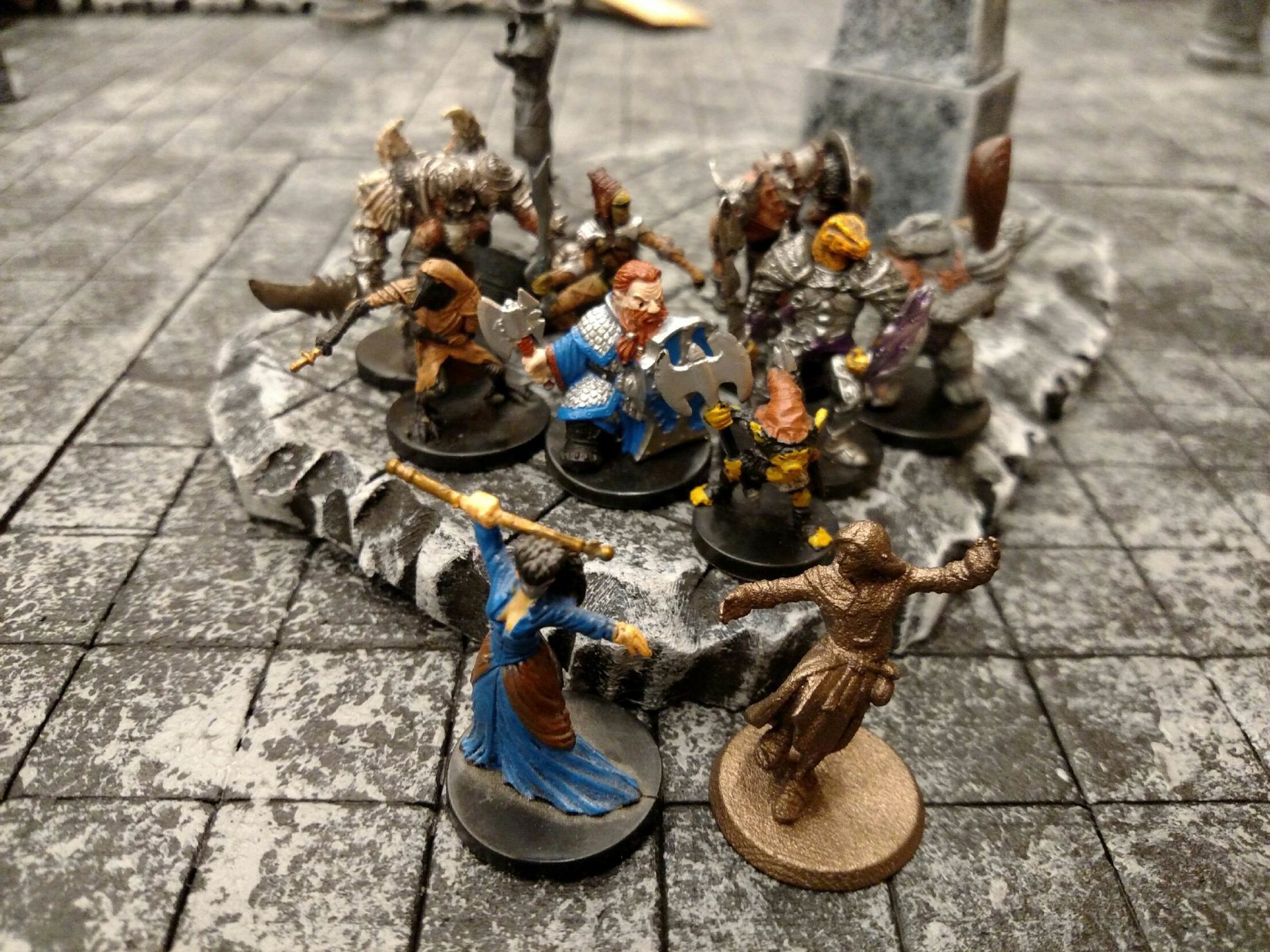
Brian Stillman:
I had a really, really fun time playing my first game of Frostgrave. I’ve always been a bit turned off by miniature combat games because they seem to be extremely complicated and crunchy. On top of that, they require the strategy of chess, and that’s not really my forte. Give me a roleplaying game any day. But Frostrgrave seemed different, more akin to the combat rules in an RPG. Definitely something I could wrap my head around.
Turns out play was simple and fast-paced, and, most importantly, easy to learn. I was surprised at how quickly I picked up the different turn actions, and by the second round I really felt like I had a handle on things. Many of my stumbling blocks stemmed from lack of experience—not knowing how to most effectively use the different people in my war party, not knowing all the spells off the top of my head, stuff like that. But that’s the kind of thing you pick up by playing, and even after only one game, I felt like I was starting to get a grip on things.
There’s a lot of room in Frostgrave for individual players to have moments of glory—and that’s a lot of fun. At one point, when it looked like one of my opponents (Joseph) was going to make off with the loot, I effectively shut him down through some clever casting of the Wall spell. Well… I thought I did. He had his own moment of triumph when he cast some spells that allowed his wizard to leap into the fray, grab the treasure, and leap out again. I was foiled, but the coolness factor took some of the sting out of it.
I know the game is meant as a one-on-one experience, but I actually liked the chaos inherent in a two-on-two game. It doesn’t take long before you’re engaging your opponent, and that’s fun. And while we didn’t coordinate too often, I could see the potential for it.
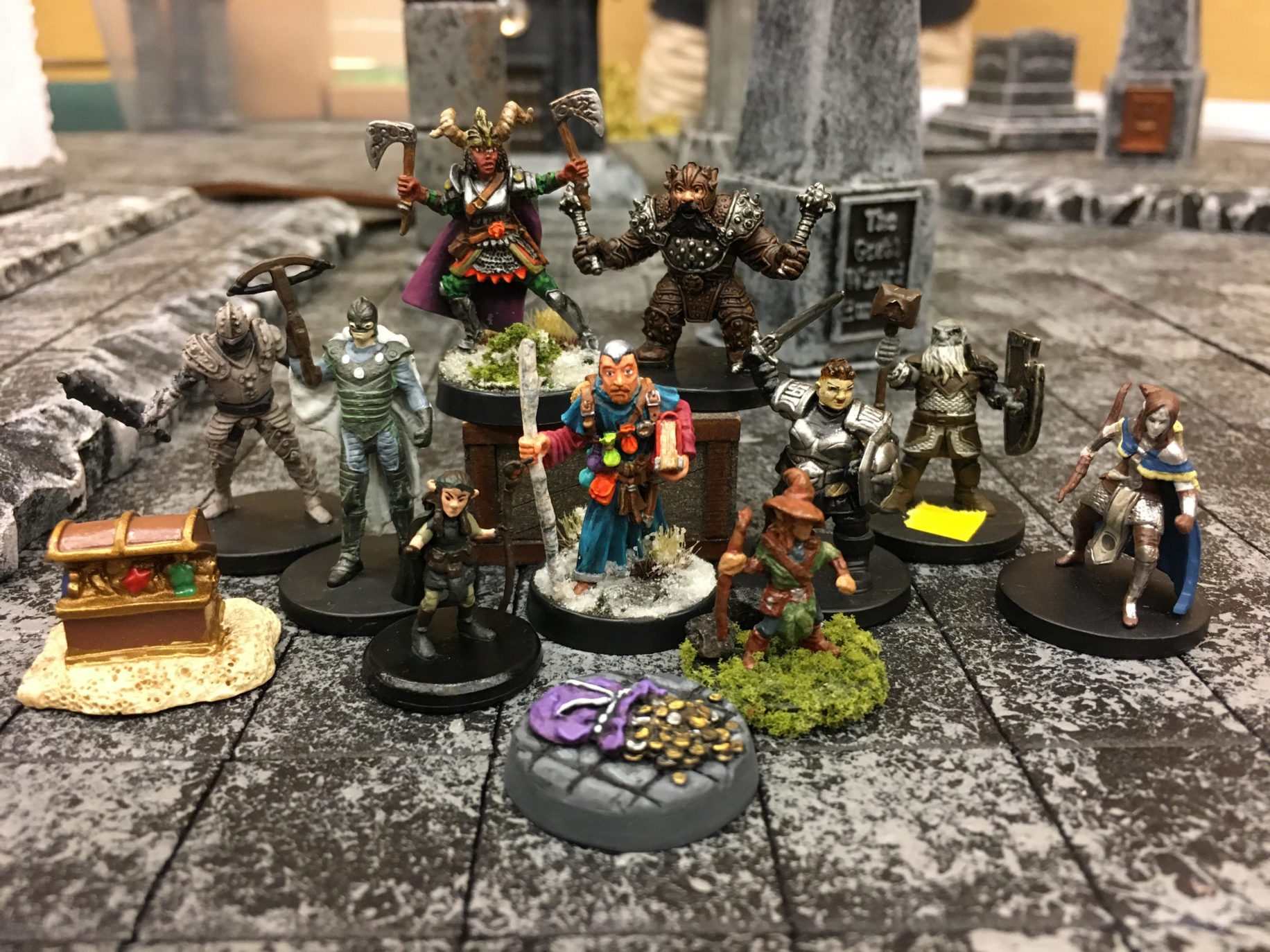
I like that you don’t need to have fancy terrain or miniatures to play. However, they do add a lot, and help make the game feel more immersive than something like chess. It’s window dressing, but effective window dressing. I’m definitely inspired to paint more members of my warband, and to start making some terrain pieces.
Having the opportunity to play with the game’s creator was fantastic. I’m the kind of person who really likes learning about the thought process that goes into games, the background, the history—being able to ask those questions while we were gaming was a lot of fun.
RPGs will always be my main love, but Frostrgrave, more than any other game I payed at Gen Con, stuck with me long after I got home. I’ve already spoken to a couple friends about playing, and I reached out to a local comic store about perhaps hosting a night. Everyone seems enthusiastic about the idea.
And that’s another thing I like about the game—it’s easy to learn to play, and then it’s easy to take to your friends. With RPGs, players need a lot of training before they know the rules well enough to run their own game. Frostgrave is such a compact, simple system that I feel completely confident, after only one game, that I can put something together with my friends and confidently navigate the rule system.
Battle Report for Frostgrave 2v2 game at Gen Con 50, August 19, 2017
Four players—Joe McCullough (Enchanter), James Floyd Kelly (Summoner), John Booth (Enchanter), Brian Stillman (Elementalist)
Joe and John were on one team and James and Brian the other. Each team placed their two warbands on opposite sides of the 3’x3′ play area. The scenario played was The Mausoleum. Four treasures were placed, one touching each corner of the central structure. Each player also placed another treasure (for a total of eight treasures on the table) per the Frostgrave rules. Only Core book rules were used. At the end of each turn, a random dice roll determined from which of the four doors a random skeleton would exit.

Key Highlights:
- Joe was the first player to get a treasure off the map.
- James’ Wizard successfully cast a Fog spell behind Joe’s Wizard and warbands. The idea was to send two thugs around behind him and do a sneak attack. It backfired—Joe cast Enchanted Hammer on his Gnoll’s weapon and sent him running back through the fog where he took out James’ thugs.
- Brian successfully cast a series of Wall spells to block off two members of Joe’s warband trying to escape with treasure tokens. Three walls in all, but John’s Apprentice finally managed to cast Leap on Joe’s Wizard to get him over the wall and out with a treasure.
- James’ Wizard failed three times to cast Summon Demon and took some serious damage. Always remember—a failed spell can mess your Wizard’s day up. Three of them? Really, REALLY bad day for your Wizard.
- John had a Warhound that attacked two of James’ thugs. The Warhound was taken down to a single hit point before it finished off both thugs.
- James’ Thief ran by a closer treasure to take one of the farther treasures. His wizard cast Leap and got the Thief off the board with a treasure. James’ Wizard also raised a zombie who carried off the closer treasure.
- Creature rolls and Judge’s Calls were made by Osprey Games teammate, Phil. Thanks, Phil, for moderating!
- Four skeletons were randomly rolled during the game. Three of them appeared at the mausoleum door closest to James’ warband. (A special investigation committee is being formed to investigate.)
- James’ Wizard and Apprentice and Marksman survived… other seven warband members were taken out for the biggest loss by a single player, but he did manage to snag two treasures. Brian got the other two!
Final score was a tie, 4-4. Total game time was 3 hours (7pm to 10pm). No one lost their Wizard or Apprentice.
Below are some photos from the game:











Finally, for those of you looking for some fiction set in the world of Frostgrave and Ghost Archipelago, there are two books that will be available shortly. The first is a collection of short stories titled Frostgrave: Ghost Archipelago — Tales of the Lost Isles. It will be released on October 24, 2017. I’m about halfway done with the book and it really is helping set the mood for the Ghost Archipelago locale. Nine tales in all, written by writers who have obviously read the core book rules and understand the roles and legends and creatures.

The second book is titled Frostgrave: Second Chances – A Tale of the Frozen City (written by Matthew Ward) and is due out November 21, 2017. Here’s the synopsis:
Time is running out for Yelen and Mirika Semova. Although the sisters have a gained a reputation for success among the explorers of the Frozen City, their lives are haunted by a curse that hangs over Yelen. The more she uses her magic, the closer the demon Azzanar comes to claiming her, body and soul. When the sisters recover a strange artifact, dark truths are revealed, old alliances are broken, and the sisters are separated. Each sister is faced with terrible choices. Who will they turn to for help, and what price will they pay to get it?
It’s a great time for Frostgrave fans… and even BETTER time for anyone looking to jump into wargaming. I continue to be surprised by how fast wargaming is growing at a local gaming store. I love RPGs, but there’s something to be said for gluing some minis together, painting them up, and tossing them into a battle with an opponent. I absolutely enjoy making game terrain to toss on the table, too. As a matter of fact, here’s a video I recently added to my YouTube channel where I show how I made the mausoleum centerpiece that we used in our game above. (Episode 23 is a wrap-up episode of my experiences at Gen Con 50, with some closeups of my warband minis if you’re interested.)
I gave the mausoleum to Joe McCullough when the game was over—my way of saying thanks to him for taking to play with us, but also just a big thank you for creating such a fun wargame. Give Frostgrave a read and try a game… I’m betting you’ll enjoy it just like Brian and John. If you have any questions, post them in the comments and I’ll do my best to answer.
Now… off to create some Ghost Archipelago terrain.
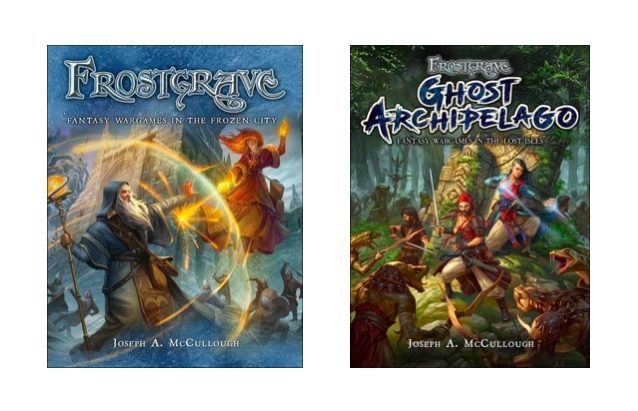

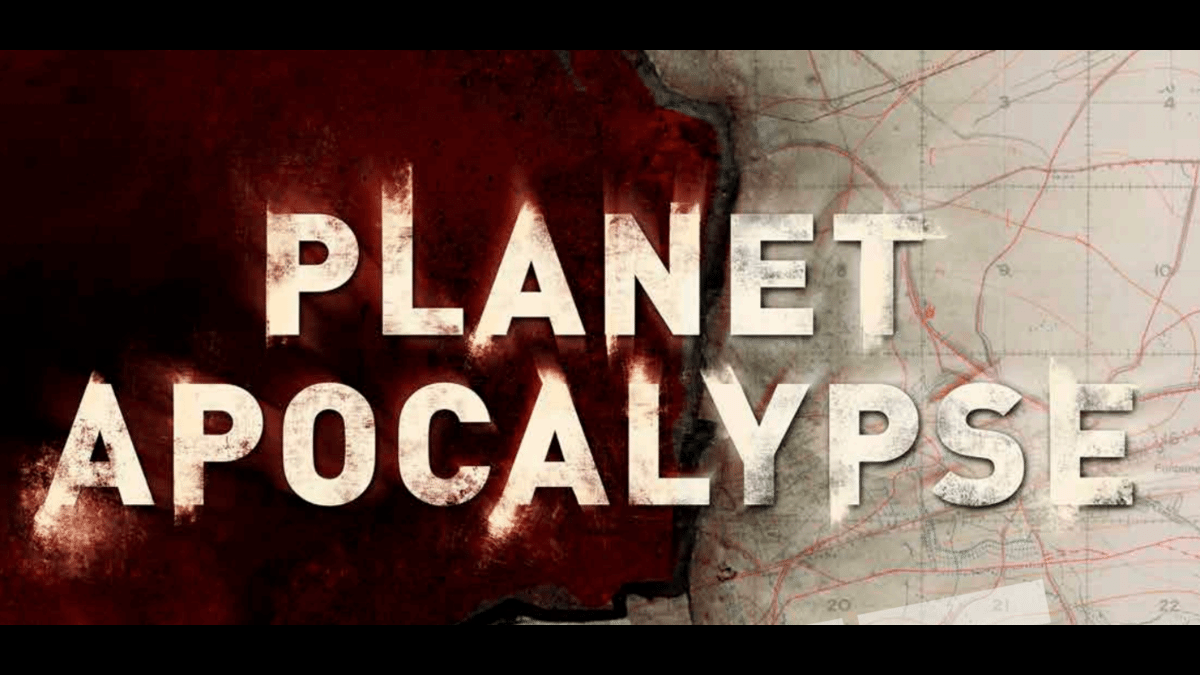

So, we ave played a number of wargames nd probably like LotR SBG and Deadzone best but we are not massively experienced at either. Genre aside, which of these 2 do you think will be the easier for new players to get into?
Honestly, Torin, they are BOTH about the same in terms of complexity. Combat is identical — two players roll dice, add in modifiers, compare results. Winner of the roll does damage based on his/her roll versus the loser’s AC. (This doesn’t happen with ranged attacks).
I would say there is a larger variety of spells with Frostgrave. Each school has 8 spells so a total of 80 spells. The Heritors in Ghost Archipelago can choose five of 30 unique abilities. Wardens in GA also choose spells, but the list is shorter than FG.
Here’s the thing — for someone who has played neither game, I would suggest that the deciding factor be on which type of terrain you and your opponent(s) would prefer — ruinous, ice and snow covered locale or jungle theme? There is a LOT of terrain out there for FG… but with GA close to release, I’m seeing a lot of 3rd party terrain companies offering terrain that would fit with the island theme.
Ultimately, GA is a derivative of Frostgrave, but with enough differences that anyone who plays both will find a nice change of scenery, skills, and tactics. My 10 year old son has just decided he now wants to play Frostgrave, so I’m teaching him in small sessions. He’s picked it up quickly, and he has zero wargame experience.
FG and GA are amazingly fun little skirmish wargames, and I think you’ll enjoy whichever one you choose. If it’s a hard call, buy both core books. They’re inexpensive and you can read each in a single sitting.
Is there a map overview of the Ghost Archipelago?